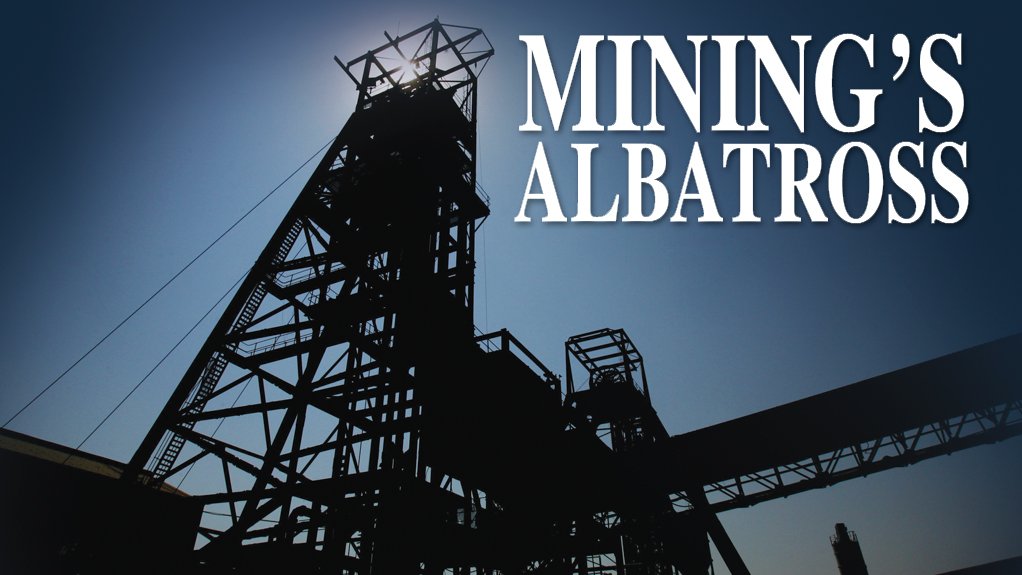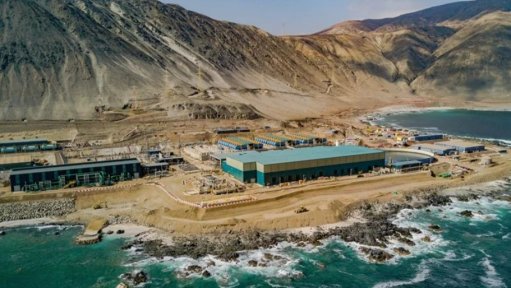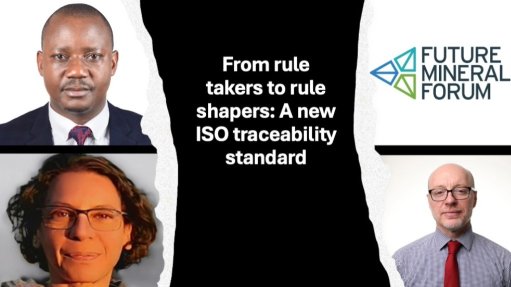Regulatory uncertainty casting shadow over South Africa amid forecast for further minerals market uptick
The South African mining industry has had a tumultuous time because of the controversial Reviewed Draft Broad-Based Black Economic Empowerment Charter for the South African Mining and Minerals Industry, also known as Mining Charter III, which, amid lingering political uncertainty, led to low investor confidence and continuing breaches of trust between government and industry, resulting in declining constructive engagement.
The charter and its potential impact remain the main cause for concern for the industry, say many industry commentators.
The events of the next few months “will do a great deal” to determine the local mining industry’s prospects over the next several years, according to industry body the Chamber of Mines (CoM).
The much-talked-about Mining Charter III, published in June last year by Mineral Resources Minister Mosebenzi Zwane, has resulted in legislative contestation, including an interdict application to suspend the implementation of Mining Charter III and a review application to set aside Mining Charter III.
The first case involves litigation against the Department of Mineral Resources, which involves the application for a declaratory order on the “recognition of continuing consequences of past [black economic empowerment] transactions” brought by the CoM following the release of Mining Charter III. Judgment was reserved on the matter, which was heard on November 9 and 10 before a full bench of the High Court, in Pretoria.
The CoM and Cliffe Dekker Hofmeyr corporate and commercial practice director Giada Masina notes that it is not clear when judgment will be delivered.
The second case – the CoM’s application to review Mining Charter III – has been postponed to February 19 to 21. The basis of the CoM’s case is the lawfulness and constitutionality of several clauses of the reviewed charter, as well as the lawfulness of the charter as a whole.
Provisions in the charter, which would have major and far-reaching implications, include requirements on ownership relating to mining and prospecting rights, including a requirement that 1% of turnover flows to empowerment shareholders, and procurement. If promulgated in its current form, “the industry believes that implementation of the reviewed Mining Charter III will be detrimental to the long-term sustainability and viability of the mining sector”, according to the CoM.
Trade unions Solidarity and the National Union of Mineworkers have been included as friends of the court in the case, while several communities have been admitted as co-applicants.
Despite the matter being addressed in February, Masina believes that a very protracted legal battle may ensue. “This battle could take us all the way to the Constitutional Court and span a good couple of years,” she acknowledges, stressing that it would be “the last thing everybody needs”.
Cliffe Dekker Hofmeyr mining head Allan Reid fears that the litigation may lead to greater disharmony between government and industry.
Masina suggests that the only way in which a solution may be forthcoming is for “government and industry to come to the table and negotiate a workable solution”.
Engineering and scientific consultancy SRK Consulting South Africa MD Vis Reddy echoes Masina’s sentiments, emphasising that “getting all the role-players together in a genuine desire to find a solution . . . will bring a major improvement in sentiment towards the mining industry – for . . . South African . . . and international investors”.
The CoM agrees, reiterating that, while it is confident that it has strong cases in respect of its applications, it realises that a legitimate charter ultimately needs to be negotiated between all interested stakeholders.
“In this light, we have had initial talks with representatives of organised labour and mining communities, and nongovernmental organisations. We also look forward . . . to an opportunity in the future to engage on this with government leaders of integrity,” the CoM states.
Similar to the CoM’s belief that “the nature of a new Mining Charter will be critical to the sustainability of the industry”, resources consultant and successful junior company entrepreneur and geologist Dr John Bristow suggests that “a complete rewrite or revamp of mineral policies in South Africa [could make the country] a destination of choice, which it should be”.
Adding to the uncertainty with regard to the legal matters is the finalisation of the Mineral and Petroleum Resources Development Act (MPRDA) amendments, which the mining industry is awaiting.
“The nonfinalisation of the MPRDA Amendment Bill has exacerbated regulatory uncertainty. Finalising the Bill as soon as possible would promote certainty and confidence in respect of the industry’s regulatory framework, provided, of course, that the amended MPRDA will be legally unassailable and workable,” the CoM posits.
Masina agrees, but notes that, while eight of the nine provinces support the Bill, subject to substantial amendments being made, and with one of the provinces having requested additional time to submit its report, the timing of the finalisation of the Bill remains uncertain.
Mineral Resources Deputy Minister Godfrey Oliphant noted last month that finalisation of the Bill and new updates could be expected this year.
Further, what underpins these regulatory dilemmas in a very substantial way is the impact on the prospects of the industry and the country of the now concluded five-yearly national elective conference of the African National Congress (ANC), which was held in December, in Gauteng, and which will determine how the politics of the country unfold in 2018.
Bristow believes that, if Cyril Ramaphosa, as the new party leader, recognises the importance and progression of a robust minerals industry, there could well be some positive outcomes.
Conversely, if he does not appreciate the importance of the mining industry and the need for enabling policy, “South Africa will continue to languish in the doldrums and be left behind by the rest of the world”, he warns.
“Several political events and any improvement in the regulatory environment in South Africa could significantly improve or strengthen the rand, which could offset a lot of the benefits of the turnaround in commodity prices,” SRK Consulting partner and principal consultant Andrew van Zyl comments, reiterating that political and regulatory fluctuations impact on the rand.
COMMODITY CONCERNS
Core Consultants MD Lara Smith believes that 2017 certainly was better than 2016, with an uptick in commodity prices and demand, and renewed interest in exploration and development in most international minerals jurisdictions, the notable omission being South Africa.
She says this was especially true in the first half of 2017, when the price of copper increased by about 9% as a result of increased manufacturing and infrastructure spend in the US and the European Union, as well as stable demand from China. Gold benefited because of political tensions, increasing by about 10%, which she attributes to increased tensions in the Middle East and North Korea.
Meanwhile, cobalt and palladium are two commodities that have benefited from the clean technology/energy revolution, with the automotive industry driving demand growth. Cobalt was the best performer for 2017, having increased by 69% since 2016, while palladium increased by 22%.
Additionally, uranium is making a comeback, increasing by 12% and garnering significant investor interest. The growth for uranium, from the deficit and ensuing price increase, has been supply-led, which means that supply has been taken out of the system. “Anything that is taken out can usually be put back, so the deficit, or perceived deficit, is less robust, compared with other commodities,” Smith says.
She is, however, more excited about the prospects for palladium and cobalt, as price increases seem to be driven by demand, which has caused the deficit.
Smith adds that the worst commodity performers include iron-ore, which has decreased by about 18% to 20%, while nickel has been volatile, declining by about 7%. However, according to the CoM, demand for high-quality South African iron-ore, mainly from China, remains high.
Importantly, with coal being the largest South African commodity export, the coal price resurgence since July 2015 to the same level as during the peak period of 2008 has been beneficial.
Despite platinum prices recovering in the middle of 2016, the commodity has since been on a downward trend, says the CoM.
RENEWED FOCUS ON EXPLORATION
While mining companies focused on rightsizing, cost containment and operational efficiency in 2016 and 2017, Van Zyl believes that reserve and resource replacement will come to the fore.
“There has been a strong bias towards brownfield expansion, but there has to be a move to greenfield opportunities and there has to be investment in exploration and new projects,” he stresses, echoing sentiments on the need for exploration by SRK Consulting partner and principal mining engineer Marcin Wertz.
Exploration and support for junior developers are also key for Bristow, who stresses that these aspects are crucial in turning South Africa around from its path of disinvestment and job destruction, and reshaping an industry where mining is currently shedding jobs daily and has become a sunset industry.
“We can encourage exploration – to do that, you need far more enabling policy to make this business healthy again,” he advises.
The SRK commentators all point to significant challenges. Some mining majors have experienced difficulty in having exploration licences/permits approved. A key example is diamond miner De Beers Consolidated Mines, which has 54 prospecting licence applications, some of which have been held up for two years. The miner has noted that it would be “unlikely to continue budgeting R30-million to R40-million a year for greenfield diamond exploration in South Africa”.
Yet, all commentators highlight that South Africa remains a treasure trove of mineral resources.
Smith notes, encouragingly, a definite increase in appetite for mining projects, pointing out that Core Consultants has been called on to assist exploration companies in acquiring and/or shortlisting opportunities in this sector.
Similarly, Smith explains, from 2013 to 2016, prospective clients have sought out assets that could easily be monetised. The investment bracket of $20-million to $150-million seemed to be “the sweet spot”, with companies wanting a brownfield or distressed asset requiring minimal capital to increase the asset’s productivity or for expansion at a later stage.
“However, if we contrast this with the current situation, we are seeing more appetite for higher-risk projects, and so companies are calling on us to even source greenfield opportunities in minor metals (so-called ‘battery metals’), precious metals and base metals, as there is enough liquidity and risk appetite to raise money to acquire these projects,” Smith says.
Nevertheless, commentators agree that regulatory uncertainty has also impacted on foreign direct investment, with investors losing confidence and adopting a wait-and-see approach towards South Africa.
Whether the country can hold the interest that remains apparent is yet to be seen, with the ANC elective conference results a matter of high interest.
South Africa is ranked in the bottom quartile in the 2017 Mining Journal World Risk Report (featuring the MineHutte ratings), which includes the Investment Risk Index, while better-rated jurisdictions from Africa include Morocco, Cote d’Ivoire, Botswana Zambia and Ghana, Wertz points out, suggesting this demonstrates South Africa’s declining relevance on the world stage.
2018 PROGNOSIS
Despite this tough environment, the mining industry remains vital to South Africa’s socioeconomic performance.
The industry achieved R424-billion in mineral sales in 2016, with 25% of South Africa’s exports having come from primary minerals.
That year, 457 698 direct jobs were sustained in the industry, representing 7.9% of private-sector employment, while R120-billion was spent on employees’ emoluments and R20-billion on corporate taxes and royalties.
Further, R304-billion was contributed to gross domestic product (GDP), representing a 7.3% direct contribution to GDP and about 18% of GDP if all the multipliers were added, according to the CoM.
However, commentators remain cautious about the South African mining industry’s future this year, suggesting that uncertainty will continue until there is certainty, derived from the outcome of pending litigation. The threat of a further credit ratings downgrade also remains on the horizon, which Masina believes could further impact on the industry.
All the industry experts interviewed do, however, foresee a further uptick in the international minerals industry as a result of improving commodity prices, with Smith expecting demand for minor metals to continue and investment to increase in commodities in the coming year. Yet, she, like others, suggests that South Africa will not be the main beneficiary of exploration investments and new developments.
Bristow suggests that, with a change in leadership and meaningful transformation, the South African mining industry could improve in attitude and performance within months, and could probably start competing on the world platform again within 18 months.
“We have all the ingredients to make our industry a whole lot better – we just need the leadership and policies to allow for it to happen,” he concludes.
Article Enquiry
Email Article
Save Article
Feedback
To advertise email advertising@creamermedia.co.za or click here
Announcements
What's On
Subscribe to improve your user experience...
Option 1 (equivalent of R125 a month):
Receive a weekly copy of Creamer Media's Engineering News & Mining Weekly magazine
(print copy for those in South Africa and e-magazine for those outside of South Africa)
Receive daily email newsletters
Access to full search results
Access archive of magazine back copies
Access to Projects in Progress
Access to ONE Research Report of your choice in PDF format
Option 2 (equivalent of R375 a month):
All benefits from Option 1
PLUS
Access to Creamer Media's Research Channel Africa for ALL Research Reports, in PDF format, on various industrial and mining sectors
including Electricity; Water; Energy Transition; Hydrogen; Roads, Rail and Ports; Coal; Gold; Platinum; Battery Metals; etc.
Already a subscriber?
Forgotten your password?
Receive weekly copy of Creamer Media's Engineering News & Mining Weekly magazine (print copy for those in South Africa and e-magazine for those outside of South Africa)
➕
Recieve daily email newsletters
➕
Access to full search results
➕
Access archive of magazine back copies
➕
Access to Projects in Progress
➕
Access to ONE Research Report of your choice in PDF format
RESEARCH CHANNEL AFRICA
R4500 (equivalent of R375 a month)
SUBSCRIBEAll benefits from Option 1
➕
Access to Creamer Media's Research Channel Africa for ALL Research Reports on various industrial and mining sectors, in PDF format, including on:
Electricity
➕
Water
➕
Energy Transition
➕
Hydrogen
➕
Roads, Rail and Ports
➕
Coal
➕
Gold
➕
Platinum
➕
Battery Metals
➕
etc.
Receive all benefits from Option 1 or Option 2 delivered to numerous people at your company
➕
Multiple User names and Passwords for simultaneous log-ins
➕
Intranet integration access to all in your organisation





















